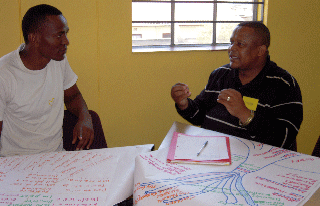
The Tree of Life methodology, developed by Ncazelo Ncube (REPSSI) and David Denborough (Dulwich Centre Foundation), has now been used in many countries around the world.
Over time, we will add stories and accounts from workers and communities in South Africa who are using the Tree of Life to respond to various forms of trauma and hardship.
Re-rooting leadership identities
Rev. Spiwo Xapile and Ariella Tilsen
In February 2009, we led a week-long narrative leadership workshop in Gugulethu, South Africa, for 13 ministers who are also leaders of their communities. We used the Tree of Life to help participants see, knit together, and then reclaim the richness of their past and present, and to unpack their hopes for the future of their congregations and communities. Using the Tree of Life to explore and bring forth the seeds of each participant’s leadership identity proved to be a powerful experience.
Ariella learned about the Tree of Life at a Winnipeg workshop led by David Denborough and Cheryl White, and immediately thought of adapting it to the leadership training that she and Spiwo were planning.
When Spiwo first heard about the Tree of Life, he was a bit concerned about what would happen when participants were asked to identify their roots. A very strong clan orientation, which includes a patriarchal lineage, persists among black South Africans. Yet because of apartheid’s harsh and intentional breaking of family bonds, many people grew up (and continue to grow up) knowing their mothers’ side, but never getting to know their fathers’ side. As a result, a lot of children struggle with identity. This is especially difficult for boys who don’t know their fathers’ roots. So to talk about roots in black South Africa is to touch a deep wound that has not healed. Even today, many people do not want to talk about their families and their roots.
During the Tree of Life activity, several participants struggled with articulating their own roots. In one case, a participant wanted to draw and name only those roots he wanted to remember—other roots were too painful to recall. Another participant told Ariella that he had been abandoned as a small child and didn’t know about his past. So Ariella asked him questions about significant people in his life who helped root and ground him as he grew up. Only then, in re-situating his experience, was he able to begin drawing from the strength and nurturing he received from those people.
Spiwo noticed that several participants, in spite of weak or limited roots—or multiple traumas to those roots—had developed the strength and sturdiness to grow their leadership narratives. They did this by focusing on and privileging whatever nourishment they did receive from others. They acknowledged and claimed the sustenance, care, knowledge, and wisdom they received, and spoke of the specific people and experiences that shaped their values, skills, and accomplishments. In revisiting their roots—and their current achievements—with a fresh sense of pride, they were able to re-root their leadership identities with vigor and power. This, in turn, revitalized each participant’s vision for their community, and opened up fresh possibilities and hope.

Rantshoke David Makhema
March 1, 2022It is very encouraging to learn about the Tree of Life. It is very relevant , especially in our Community that was displaced by apartheid during the forced removals. Today(01/03/2022), we have not as yet received our land back even though there is a Court Order directing the authorities to finalise the claim. The Tree of Life together with other Narrative Tools has a potential to rebuilt our once vibrant and hard working Community.
David Makhema
makhemad@gmail.com
Republic of South Africa